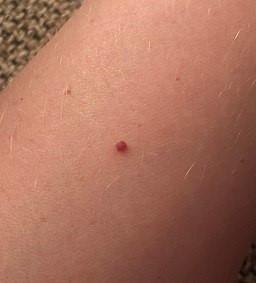Campbell de Morgan-Spot
Begutachtet von Dr. Toni Hazell, MRCGPZuletzt aktualisiert von Dr. Rachel Hudson, MRCGPZuletzt aktualisiert am 31. Oktober 2024
Erfüllt die Anforderungen des Patienten redaktionelle Richtlinien
- HerunterladenHerunterladen
- Teilen Sie
- Sprache
- Diskussion
Medizinisches Fachpersonal
Professionelle Referenzartikel sind für Angehörige der Gesundheitsberufe bestimmt. Sie werden von britischen Ärzten verfasst und basieren auf Forschungsergebnissen, britischen und europäischen Leitlinien. Vielleicht finden Sie einen unserer Gesundheitsartikel nützlicher.
In diesem Artikel:
Synonyme: Kirschblütige Hämangiome, senile Angiome
Lesen Sie unten weiter
Was sind Campbell de Morgan-Spots?
Campbell-de-Morgan-Flecken, auch Kirschangiome genannt, sind häufige, gutartige Hautläsionen mittleren bis höheren Alters, die durch wuchernde, erweiterte Kapillaren und postkapilläre Venolen entstehen. Sie sind nach dem englischen Chirurgen Campbell de Morgan (1811-76) benannt.
Ursachen der Campbell de Morgan-Flecken (Ätiologie) 1 2
Ihre Ursache bleibt unbekannt:
Einzelne Studien haben über eine erhöhte Inzidenz bei tropischem Klima, Diabetes, Transplantationspatienten und immungeschwächten Personen berichtet.
Schwangerschaft und Prolaktinome werden mit der Entwicklung von Läsionen in Verbindung gebracht, was auf hormonelle Mediatoren hindeutet.
Die Zahlen steigen mit dem Alter, so dass Faktoren, die mit dem Alterungsprozess zusammenhängen, eine Rolle spielen können.
Eine chemische Belastung (Senfgas, 2-Butoxyethanol) führt zur Entwicklung multipler Läsionen.
Lesen Sie unten weiter
Wie häufig sind Campbell-de-Morgan-Flecken? (Epidemiologie)1 2
Sie sind die häufigste kutane Gefäßwucherung. In letzter Zeit wurden nur wenige Berichte veröffentlicht, aber man geht davon aus, dass bis zu 75 % der über 75-Jährigen davon betroffen sind.
Sie nehmen mit dem Alter an Häufigkeit und Größe zu.
Sie nehmen ab dem 40. Lebensjahr an Häufigkeit zu.
Sie können überall auftreten, sind aber am häufigsten am Stamm zu finden.
Sie kommen bei allen Ethnien und Geschlechtern vor.
Visuelles Erscheinungsbild
Kirschenangiom am Arm eines Erwachsenen

Von Midasblenny, CC BY-SA 4.0über Wikimedia Commons
Makel mit einem Durchmesser von 1-3 mm, die mit der Zeit zu größeren Papeln werden können.
Typische leuchtend kirschrote Farbe, kann aber auch blau oder violett erscheinen.
Sie sind nicht bleichend.
Lesen Sie unten weiter
Präsentation
Sie treten meist am Rumpf und an den oberen Extremitäten auf.
Sie können an jeder Hautstelle außer den Schleimhäuten vorkommen. Es wurde von der Kopfhaut berichtet.1
Die Läsionen können weit verbreitet sein, insbesondere bei älteren Menschen.
Sie sind in der Regel asymptomatisch.
Differentialdiagnose
Die Diagnose ist in der Regel klinisch eindeutig. Differentialdiagnosen können sein:
Angiokeratom.
Venöse Seen (blaue Angiome, meist an den Lippen).
Campbell de Morgan Spots Management
Beruhigen Sie sich - diese Läsionen erfordern in der Regel keine Behandlung.
In sehr seltenen Fällen kann eine Entfernung erforderlich sein, wenn die Läsionen auffallen oder aus kosmetischen Gründen.
Wenn eine Entfernung gewünscht wird, gibt es folgende Behandlungsmöglichkeiten: Kürettage, gepulster Farbstofflaser, Elektrokauterisation und Exzision.
Die Verödungstherapie hat sich ebenfalls als wirksam erwiesen.3
Wann ist eine Überweisung erforderlich?
Wenn diagnostische Unsicherheiten bestehen.
Wenn Hilfe beim Umzug erforderlich ist.
Prognose
Campbell-de-Morgan-Flecken sind gutartige Läsionen.
Probleme entstehen nur dann, wenn die Läsionen häufig traumatisiert sind, sich weiter vergrößern oder für den Patienten kosmetisch bedenklich sind.
Weiterführende Literatur und Referenzen
- Seniles AngiomDermIS (Dermatologie-Informationssystem)
- Higgins JC, Maher MH, Douglas MSDiagnose von häufigen gutartigen Hauttumoren. Am Fam Physician. 2015 Oct 1;92(7):601-7.
- Angiom (erworben) - einschließlich Kirschenangiom / Campbell de Morgan-FleckenGesellschaft für Dermatologie in der Primärversorgung (PCDS)
- Kim JH, Park HY, Ahn SKCherry Angiomas auf der Kopfhaut. Case Rep Dermatol. 2009 Nov 11;1(1):82-86.
- AngiomeDermNet NZ
- Jairath V, Dayal S, Jain VK, et alIst die Verödungstherapie bei Kirschangiomen sinnvoll? Dermatol Surg. 2014 Sep;40(9):1022-7. doi: 10.1097/01.DSS.0000452631.83962.58.
Lesen Sie unten weiter
Artikel Geschichte
Die Informationen auf dieser Seite wurden von qualifizierten Klinikern verfasst und von Fachleuten geprüft.
Nächste Überprüfung fällig: 30. Oktober 2027
31. Oktober 2024 | Neueste Version

Fragen, teilen, verbinden.
Stöbern Sie in Diskussionen, stellen Sie Fragen, und tauschen Sie Erfahrungen zu Hunderten von Gesundheitsthemen aus.

Fühlen Sie sich unwohl?
Beurteilen Sie Ihre Symptome online und kostenlos